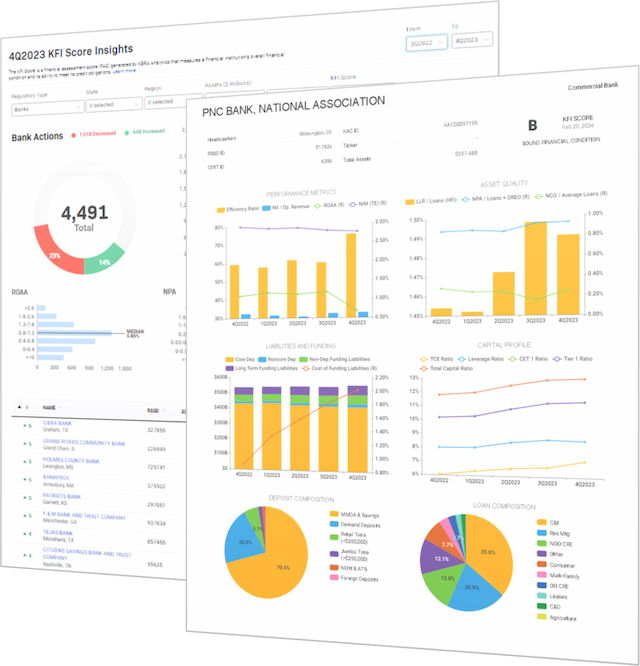KBRA Financial Intelligence
U.S. Banks Exceeding CRE Regulatory Guidelines Wane in Second Quarter
By KFI Staff
The number of banks with commercial real estate (CRE) loan concentrations above regulatory guidelines fell slightly in Q2, the first decline in two years.
Regulators identify lenders for further scrutiny when they exceed one of two thresholds: construction loans surpassing 100% of risk-based capital, or CRE loans above 300% of risk-based capital levels and 50% growth in CRE over the last three years.
The number of lenders in Q2 that met either of these criteria decreased slightly, to 567 from 573, after climbing from a pandemic low of 294 in Q1 2021, according to data compiled by KBRA Financial Intelligence (KFI) as of August 7. Federal regulators, including the Federal Reserve, FDIC, and the Office of the Comptroller of the Currency, use the criteria to help identify banks for further supervisory analysis.
The widely discussed increase in CRE stress at U.S. lenders has, so far, not shown up in financial reporting by the more than 4,000 U.S. banks. Current levels have increased but are within historical averages. The latest numbers are slightly above the most recent peak of banks above CRE thresholds in early 2017.

"There’s nothing in these bank numbers that suggest any unusual risk, beyond seeing a couple of failures a quarter or even a year," said Terry Wise, a former banker and consultant who runs BankingStrategist.com.
In recent months, regulators have cited that weak demand for CRE properties may lead to declining valuations. In May, the Federal Reserve cautioned that the shift to remote work, especially in office properties in major cities, may lead to a sizable correction in property values and to credit losses. The biggest lenders are reporting the highest levels of nonperforming CRE loans. While CRE delinquency rates for all U.S. banks rose to 0.83% in Q2, up from 0.77% in the prior quarter, lenders with more than $100 billion in assets drove much of that increase, with delinquency rates climbing to 1.38% from 1.27%, according to data compiled by KFI.
Lending limits for smaller banks, those below $100 billion, have likely insulated those lenders from declining valuations of large office towers, which typically rely on financing from large banks and institutional investors. Distressed office loans are now the largest component of KBRA’s Loan of Concern (K-LOC) Index, which is KBRA Credit Profile’s primary metric to measure stress in the CMBS conduit market. — With Anela Kobilic and Qinze Wang.

Recent M&A Transactions
Glacier Bancorp (KFI Score: B) of Kalispell, Montana, agreed on August 8 to buy Community Financial Group, Inc. and its subsidiary Wheatland Bank (B) for about $81 million. Glacier adds Wheatland’s $754 million of assets for a total of about $28 billion. The deal is expected to close in Q4.
Harborstone Credit Union (A-) agreed on August 1 to buy Seattle-based First Sound Bank (B-). The Lakewood, Washington-based credit union will surpass $2 billion in assets by purchasing virtually all of First Sound’s assets of $175 million.
Ultima Bank Minnesota (B+) filed a merger application with the FDIC on July 27 to take over Gary, Minnesota-based Gary State Bank (B-).
Atlantic Union Bankshares Corp. (B) agreed on July 25 to acquire American National Bankshares Inc (B) in an all-stock deal valued at about $417 million. The merger will combine the two Virginia lenders into a $23.7 billion asset bank.
Banc of California (B) agreed on July 25 to buy PacWest Group (B-), whose shares had dropped by about two-thirds since March following the failure of three regional lenders. The all-stock deal will create a $36 billion lender.
The First State Bank (B) in Boise City, Oklahoma, filed a merger application with the FDIC on July 24 to buy two branches of High Plains Bank (B) in Western Oklahoma.
3 Things in Credit
Follow Van Hesser’s 3 Things in Credit podcast. From the August 4 episode:
"So, what happens to spreads when stocks correct? This is not a trick question―they widen. We looked at material stock market sell-offs over the past 25 years and found that on average investment grade widened out 87 bps and high yield 318 bps."
